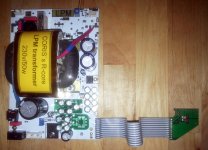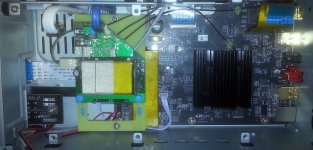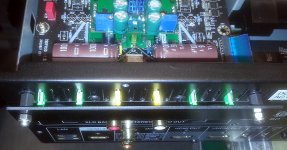It's a proven that linear supplies out perform SMPS in every area except for effientcy and since when are audio files worried about burning extra power.
Let's see the proof then. Of course there isn't any, or Audio Precision wouldn't have chosen a SMPSU in their audio analyser, given they're not much concerned about efficiency either.
I'd not recommend the HC4040 for clock division - reason being its a ripple counter. This means each stage's clock is derived from the previous stage - jitter gets added by each stage. A better choice would be something like 74LVC161 because its synchronous - all outputs are derived directly from the input clock.
Only using the HC4040 as single stage, from 50MHz to 25MHz (Oppo 95) and 54MHz to 27MHz (Oppo 105). The 74LVC161 form factor is 48 pin SMD and the non-SMD HC4040 so easy to use.
The "SAW" advantage is easily coming through the HC4040, and are both powered by the Terra Firma 3.3V - and it adds only a modest amount of added current. The point of TF is that it makes for a much more analog sound as it target sub-1 Hertz noise/jitter via power supply (it supposes than Alan Deviation is audible - some find that hard to believe). That advantage must come through the divider and it most certainly sounds that way.
Any added propagation delay may not be ideal here. The effect it may have on the TF is a worry.
So until something better comes along...?
Cheers, Joe
Abrax is right, ripple counter is not the ticket for this job.
Terry
Let's see the proof then. Of course there isn't any, or Audio Precision wouldn't have chosen a SMPSU in their audio analyser, given they're not much concerned about efficiency either.
Please don't compare Audio precision power supply to OPPO (basic) SMPS!
This is not at all the same price and shielded quality components.
But you're right, some brands are able to do excellent SMPS (Linn, Devialet...).
The efficiency of the SMPS is not just the first one parameter one look at when a producer may chose it for their products/systems. There is in fact the the low cost of such (and maybe its physical dimensions, and lack of heat dissipation). The SMPS is cheaper than the linear one, and much smaller. A very good and extremely low noise SMPS is very expensive, and such it should be used indeed when the efficiency is the first demand (high currents and/or power needed from the PSU/SMPS).
If a SMPS it was enough justified for the firsts OPPO models, where the current demanded by the systems it was around 5A or higher, then for the new models the use of SMPS for a device rated into 40W or so, is quite stupid in my appreciation. Here is not about efficiency. There is also not the problem about the available space inside the enclosure either. The only which it matter in such case is the low cost. And this it goes often over the overall product quality... Not so clever, in my appreciation, but the production costs are very important in such businesses... Low costs correlated with good marketing it sell well and make the market... And in the end it come the modders who may fix it for the quality gap...
If a SMPS it was enough justified for the firsts OPPO models, where the current demanded by the systems it was around 5A or higher, then for the new models the use of SMPS for a device rated into 40W or so, is quite stupid in my appreciation. Here is not about efficiency. There is also not the problem about the available space inside the enclosure either. The only which it matter in such case is the low cost. And this it goes often over the overall product quality... Not so clever, in my appreciation, but the production costs are very important in such businesses... Low costs correlated with good marketing it sell well and make the market... And in the end it come the modders who may fix it for the quality gap...
The working voltages are there in between 12v and 3,3v. So a max 16v rated cap it is alright for that section...
And as C44 is output of regulator at 3.3v I presume 6.3v cap ok
Smiffy
The best approach is to have the XLR output level so as it is, without no any attenuation (supposing the next amplifier device/stage it will have a analogue volume control).
Personally I will prefer a such analogue volume adjustment rather than using the inbuilt digital volume control into the Sabre DAC chip (setting the Oppo volume level on Fixed).
Personally I will prefer a such analogue volume adjustment rather than using the inbuilt digital volume control into the Sabre DAC chip (setting the Oppo volume level on Fixed).
- Home
- Source & Line
- Digital Source
- Oppo's BDP105 - discussions, upgrading, mods...


